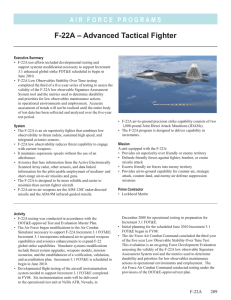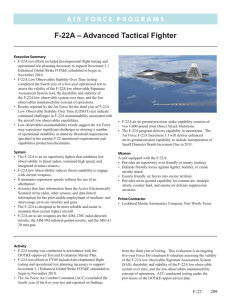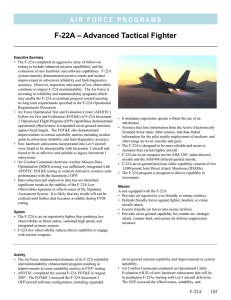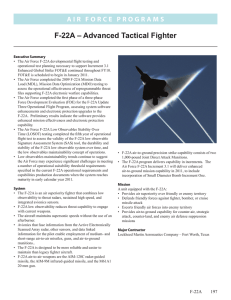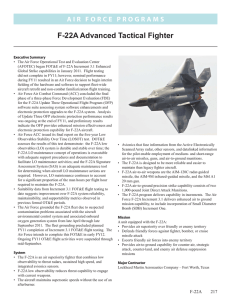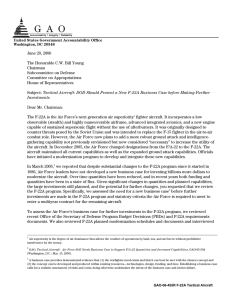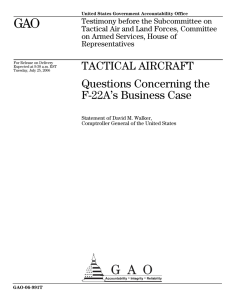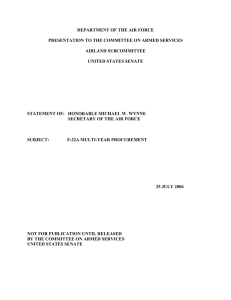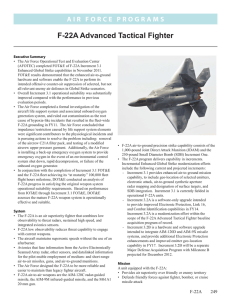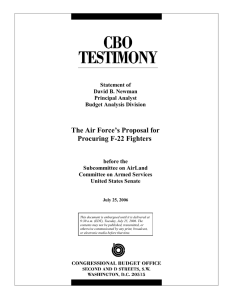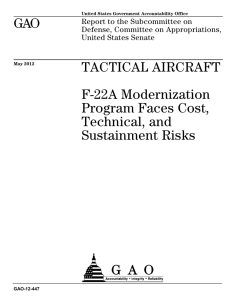Testimony of Danielle Brian Executive Director, Project On Government Oversight before the
advertisement
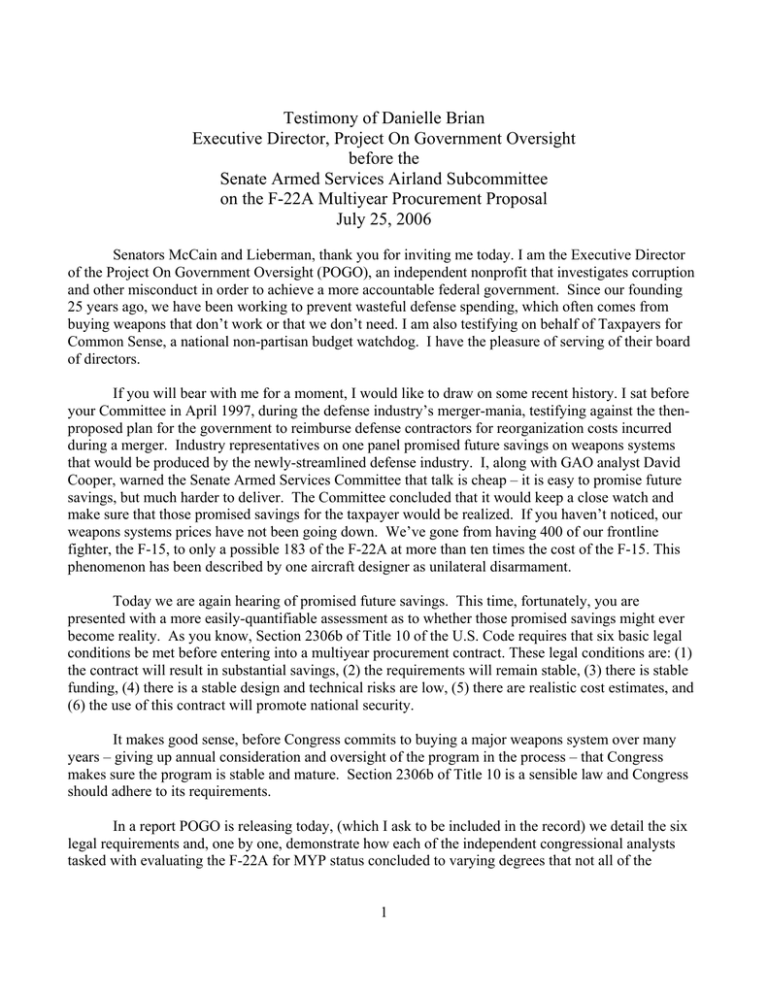
Testimony of Danielle Brian Executive Director, Project On Government Oversight before the Senate Armed Services Airland Subcommittee on the F-22A Multiyear Procurement Proposal July 25, 2006 Senators McCain and Lieberman, thank you for inviting me today. I am the Executive Director of the Project On Government Oversight (POGO), an independent nonprofit that investigates corruption and other misconduct in order to achieve a more accountable federal government. Since our founding 25 years ago, we have been working to prevent wasteful defense spending, which often comes from buying weapons that don’t work or that we don’t need. I am also testifying on behalf of Taxpayers for Common Sense, a national non-partisan budget watchdog. I have the pleasure of serving of their board of directors. If you will bear with me for a moment, I would like to draw on some recent history. I sat before your Committee in April 1997, during the defense industry’s merger-mania, testifying against the thenproposed plan for the government to reimburse defense contractors for reorganization costs incurred during a merger. Industry representatives on one panel promised future savings on weapons systems that would be produced by the newly-streamlined defense industry. I, along with GAO analyst David Cooper, warned the Senate Armed Services Committee that talk is cheap – it is easy to promise future savings, but much harder to deliver. The Committee concluded that it would keep a close watch and make sure that those promised savings for the taxpayer would be realized. If you haven’t noticed, our weapons systems prices have not been going down. We’ve gone from having 400 of our frontline fighter, the F-15, to only a possible 183 of the F-22A at more than ten times the cost of the F-15. This phenomenon has been described by one aircraft designer as unilateral disarmament. Today we are again hearing of promised future savings. This time, fortunately, you are presented with a more easily-quantifiable assessment as to whether those promised savings might ever become reality. As you know, Section 2306b of Title 10 of the U.S. Code requires that six basic legal conditions be met before entering into a multiyear procurement contract. These legal conditions are: (1) the contract will result in substantial savings, (2) the requirements will remain stable, (3) there is stable funding, (4) there is a stable design and technical risks are low, (5) there are realistic cost estimates, and (6) the use of this contract will promote national security. It makes good sense, before Congress commits to buying a major weapons system over many years – giving up annual consideration and oversight of the program in the process – that Congress makes sure the program is stable and mature. Section 2306b of Title 10 is a sensible law and Congress should adhere to its requirements. In a report POGO is releasing today, (which I ask to be included in the record) we detail the six legal requirements and, one by one, demonstrate how each of the independent congressional analysts tasked with evaluating the F-22A for MYP status concluded to varying degrees that not all of the 1 requirements have been met. The Congressional Research Service, Government Accountability Office, Congressional Budget Office, and Defense Contract Audit Agency all provide evidence that the F-22A program is not yet ripe for this type of financing scheme. Interestingly, according to an internal briefing we have obtained, even the Air Force questioned whether it could get away with claiming the program had met two of the requirements, noting they would still require waivers for the unfunded termination costs and the lack of full funding, and they were waiting for the IDA analysis on cost savings. I would like to discuss how the F-22A program does not meet the six legal requirements for multiyear procurement as set out by Title 10. Substantial Savings. The Air Force claims there will be a 2 ½% savings through the multiyear procurement, which by the way, does not impress me as substantial. But, the reality is that even after taking into account the four additional aircraft purchased through this plan, we will be spending $1 billion more because of the inefficiencies created by stretching out production over three years. According to the GAO, unit costs will also increase by $17 million per plane. None of this sounds like savings at all, let alone a substantial savings. Stable Requirements. Over the years, the number of requested F-22 aircraft has plummeted from 750 in 1986 to the most recent plan of only 183 – clearly demonstrating the lack of stability in production rate requirements – in large part because the cost per aircraft has tripled. Stable Funding. The current Forward-Year Defense Plan does not fully fund the F-22A. In fact, the program is being underfunded by $674 million, according to the Air Force. Design Stability. Attached to my testimony is the Air Force plan to fund its modernization of the F22A through 2010. The plan primarily addresses the new radar system, which is not even scheduled to be received by the Air Force until November of this year, and the software is not scheduled to be completed until 2010. This radar system is considered integral to the F-22A’s ground-attack and intelligence gathering capabilities. According to the GAO, the Air Force “is planning additional modernization efforts for more of these capabilities in the future, but the cost, content, and timing have not yet been determined.” And remember, these systems still have not been tested. In addition to the new, untested systems there are on-going technical problems with the existing systems. The Pentagon recently completed a Follow-on Independent Test and Evaluation on the existing systems, and found 75 unresolved deficiencies. New problems that have cropped up include faulty cockpit actuators – which trapped a pilot in the jet just this April--the pilot had to be rescued from his cockpit with chainsaws. Then there is the uncommanded nose landing gear retractions, which recently caused an aircraft to fall on its main weapons bay doors – literally falling on its face; and concerns about the heat treatment of the booms, which may cause structural cracking, and has been reported by Defense News as costing nearly $1 billion to fix. These and other problems all point to a system that is not mature and is in need of rigorous congressional oversight. A multiyear procurement plan would only tie Congress’ hands and not allow for such oversight. Realistic Cost Estimates. The Air Force has a history of not providing accurate cost estimates, and 2 there is little reason to believe that it will be any more accurate for this round of procurement. For instance, five years ago, the House Government Reform Subcommittee on National Security was frustrated in getting accurate F-22A program cost estimates from the Air Force. The Subcommittee had tasked the GAO with reviewing the F-22A program’s cost reduction plans. What the GAO found was a $7 billion variance between the Air Force’s cost estimates and those made by the Office of the Secretary of Defense’s Cost Analysis Improvement Group. On August 20, 2001, Subcommittee Chairman Chris Shays wrote to House Armed Services Chairman Duncan Hunter that, “. . . as you proceed with your deliberations on the pace and scope of the F-22A program, please be advised we can have little confidence in the accuracy of production cost estimates and less confidence in the legitimacy of projected production cost savings based on those estimates.” (I ask that this letter be included in the record.) In November 2005, the Defense Contract Audit Agency stated that there is “moderate to high risk...[in] cost estimate development” for the F-22A program, as they found $141 million in unsupported, inaccurate, or defective data in Air Force cost estimates. Another, more recent, incident fuels POGO’s doubts about the accuracy of the F-22A cost estimates. You may recall the debate in the Senate last spring over whether or not to support Secretary Rumsfeld's decision to cancel the C130-J cargo plane. Although the contract clearly stated that cancellation costs would be $383 million, some of the very same people handling this F-22A procurement plan circulated to the Senate wildly-inflated and unsupported claims that the C-130J’s cancellation costs would be nearly $1.8 billion. Based on that information, the Senate decided to go ahead and continue the contract. Last month, the DOD Inspector General concluded that those claims were false and based on potentially faulty data – and caused a $1.5 billion exaggeration. To my knowledge, no one has been held accountable for misleading the Congress, but there are probably many people who know they successfully pulled the wool over the Senate’s eyes. POGO’s concern is that some of the folks handling the F-22A procurement are not above wild exaggerations to ensure that their program is approved. National Security Interests. At the end of the day, perhaps the most important question remains – why are we continuing to fund a Cold War-era weapon that was designed to counter the next-generation Soviet fighters that were never constructed? In fact, the GAO stated in its June 2006 letter to House Appropriations Subcommittee on Defense Chairman C. W. Bill Young that, “Based on our review, in our opinion, the DOD has not demonstrated the need or value for making further investments in the F22A program.” While the final requirement of the law – that it promotes the national security of the United States – is a matter of judgment and is not quantifiable, the ballooning costs of this aircraft render it impossible to meet the Air Force’s own stated requirements for 381 F-22A’s “in order to meet the needs of the warfighter.” If it is too expensive to buy enough planes to meet our national security needs, this certainly challenges the assumption that the final requirement has been met. Given all of the evidence that the F-22A program is not ripe for multiyear procurement, why did the Senate vote in favor of it? In a brazen example of the Military-Industrial Complex at work, Lockheed Martin emailed the Chambliss amendment proposing F-22A multiyear procurement status to an undisclosed list of Senate offices before the amendment had even been introduced by the Senator. 3 Attached to that email was an analysis selectively touting the findings of the Institute for Defense Analyses (IDA), claiming “IDA found the F-22A meets all Title 10 entrance criteria for a multiyear contract.” That claim in the Lockheed email appears to be based on a misreading of the IDA report. IDA limited its analysis to only one requirement – that there be cost savings. However, IDA attached two unattributed documents at the end of its report which assert the F-22A meets all six requirements. Because the author of these documents is not clearly identified, the wrong impression appears to have been reached that they were IDA’s conclusions. In fact, however, these are Pentagon exhibits for the FY2007 President’s Budget and not independent analyses by IDA. When initially asked to testify today, I was also asked to address the proposal to purchase the F22A’s F119 engines through Multi-Year Procurement. In short, why should Congress commit to buying a part of the aircraft for several years, when the commitment to buying the entire aircraft is uncertain? The jury is still out on future buys of the F-22A, and there is the risk that the engines will just stack up in a warehouse with nowhere to go. In conclusion, it is clear that independent congressional analysts have significant concerns with accepting the F-22A program as a candidate for multiyear procurement. Based on its own research, POGO does not believe the F-22A program meets multiyear procurement requirements, and recommends that Congress removes the language authorizing the MYP until such time that the program meets those requirements. Thank you again for inviting me to testify today. 4 5
